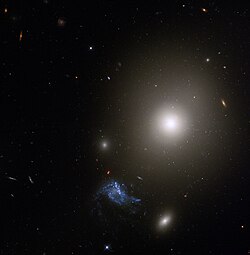Astronomy:NGC 541
| NGC 541 | |
|---|---|
 NGC 541 imaged by the Hubble Space Telescope | |
| Observation data (J2000 epoch) | |
| Constellation | Cetus |
| Right ascension | 01h 25m 44.3s[1] |
| Declination | −01° 22′ 46″[1] |
| Redshift | 0.018086 +/- 0.000019 [1] |
| Helio radial velocity | 5,422 ± 6 km/s[1] |
| Distance | 230 ± 60 Mly (70.6 ± 19.8 Mpc)[1] |
| Apparent magnitude (V) | 12.2 |
| Characteristics | |
| Type | cD;S0- [1] |
| Apparent size (V) | 1.8′ × 1.7′[1] |
| Other designations | |
| UGC 1004, Arp 133, CGCG 385-128, MCG +00-04-137, PGC 5305[1] | |
NGC 541 is a lenticular galaxy located in the constellation Cetus. It is located at a distance of about 230 million light years from Earth, which, given its apparent dimensions, means that NGC 541 is about 130,000 light years across.[1] It was discovered by Heinrich d'Arrest on October 30, 1864.[2] It is a member of the Abell 194 galaxy cluster and is included in the Atlas of Peculiar Galaxies in the category galaxies with nearby fragments. NGC 541 is a radio galaxy of Fanaroff–Riley class I, also known as 3C 40A (3C 40B is more prominent and is associated with the nearby galaxy NGC 547).[3]
The galaxy was observed by the Hubble Space Telescope. It was found that it has a central disk seen nearly face-on with a diameter of 1".8. Inside the disk is an inner ring with a diameter of circa 0".44 arcseconds, maybe part of a hardly visible spiral structure. There is also a linear dust feature sticking out of the disk with nearly the same axis as the radio jet. H-alpha and [N II] emission presented a peak at the centre of the dusk disk and also was found to form a ring around the peak, which had two brighter spots lying diametrically opposed.[4] Observations in CO emission revealed the presence of molecular gas in NGC 541, with estimated mass of approximately 108 M☉, and with a compact ring-like distribution with a radius of 1–2 kpc.[5] In the centre of NGC 541 lies a supermassive black hole whose mass is estimated to be (1.9 – 9.2) × 108 M☉.[6]
At 45 arcseconds northeast of NGC 541 lies an irregular dwarf galaxy known as Minkowski's object.[4] It is located in the path of the radio jet of NGC 541 and there is strong evidence that the jet has caused a starburst in Minkowski's object. There is a HI region downstream from the Minkowski's object with 4.9×108 M☉ that straddles the jet at the point where the jet changes direction. At least 20 regions with star clusters and associated HII regions have been detected in Minkowski's object. The stellar population in Minkowski's object is dominated by stars formed in a single event 7.5 million years ago. The current starbirth rate is 0.52 M☉ per year.[7] Although it has been proposed that Minkowski's object was a dwarf galaxy that happened to pass through the radio jet of NGC 541, it is more probable that the HI region was warm intergalactic gas that was cooled by the jet, resulting in star formation,[7][8] a model that has been reproduced by computer stimulations.[9]
A stellar bridge has been detected between NGC 541 and the galaxy pair NGC 545/547,[7] which lies 4.5 arcminutes to the northeast (projected distance circa 100 kpc).[4]
References
- ↑ 1.0 1.1 1.2 1.3 1.4 1.5 1.6 1.7 1.8 "NASA/IPAC Extragalactic Database". Results for NGC 541. http://ned.ipac.caltech.edu/cgi-bin/nph-objsearch?objname=NGC+541.
- ↑ Seligman, Courtney. "NGC 541 (= PGC 5305 = Arp 133)". https://cseligman.com/text/atlas/ngc5.htm#541.
- ↑ Sakelliou, Irini; Hardcastle, M. J.; Jetha, N. N. (February 2008). "3C 40 in Abell 194: can tail radio galaxies exist in a quiescent cluster?". Monthly Notices of the Royal Astronomical Society 384 (1): 87–93. doi:10.1111/j.1365-2966.2007.12465.x. Bibcode: 2008MNRAS.384...87S.
- ↑ 4.0 4.1 4.2 Verdoes Kleijn, Gijs A.; Baum, Stefi A.; de Zeeuw, P. Tim; O'Dea, Chris P. (December 1999). "Hubble Space Telescope Observations of Nearby Radio-Loud Early-Type Galaxies". The Astronomical Journal 118 (6): 2592–2617. doi:10.1086/301135. Bibcode: 1999AJ....118.2592V.
- ↑ Salomé, Q.; Salomé, P.; Combes, F. (20 January 2015). "Jet-induced star formation in 3C 285 and Minkowski's Object". Astronomy & Astrophysics 574: A34. doi:10.1051/0004-6361/201424932. Bibcode: 2015A&A...574A..34S.
- ↑ Beifiori, A.; Sarzi, M.; Corsini, E. M.; Bontà, E. Dalla; Pizzella, A.; Coccato, L.; Bertola, F. (10 February 2009). "UPPER LIMITS ON THE MASSES OF 105 SUPERMASSIVE BLACK HOLES FROM Hubble Space Telescope/SPACE TELESCOPE IMAGING SPECTROGRAPH ARCHIVAL DATA". The Astrophysical Journal 692 (1): 856–868. doi:10.1088/0004-637X/692/1/856. Bibcode: 2009ApJ...692..856B.
- ↑ 7.0 7.1 7.2 Croft, Steve; van Breugel, Wil; de Vries, Wim; Dopita, Mike; Martin, Chris; Morganti, Raffaella; Neff, Susan; Oosterloo, Tom et al. (20 August 2006). "Minkowski's Object: A Starburst Triggered by a Radio Jet, Revisited". The Astrophysical Journal 647 (2): 1040–1055. doi:10.1086/505526. Bibcode: 2006ApJ...647.1040C.
- ↑ Lacy, Mark; Croft, Steve; Fragile, Chris; Wood, Sarah; Nyland, Kristina (4 April 2017). "ALMA Observations of the Interaction of a Radio Jet with Molecular Gas in Minkowski's Object". The Astrophysical Journal 838 (2): 146. doi:10.3847/1538-4357/aa65d7. Bibcode: 2017ApJ...838..146L.
- ↑ Fragile, P. Chris; Anninos, Peter; Croft, Steve; Lacy, Mark; Witry, Jason W. L. (30 November 2017). "Numerical Simulations of a Jet–Cloud Collision and Starburst: Application to Minkowski's Object". The Astrophysical Journal 850 (2): 171. doi:10.3847/1538-4357/aa95c6. Bibcode: 2017ApJ...850..171F.
External links
- NGC 541 on WikiSky: DSS2, SDSS, GALEX, IRAS, Hydrogen α, X-Ray, Astrophoto, Sky Map, Articles and images
- NGC 541 on SIMBAD
133
 |

